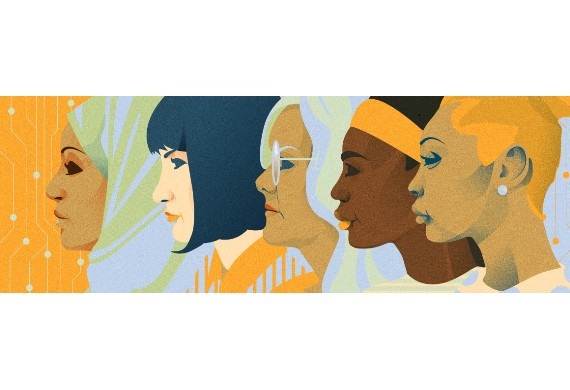
Why the World Needs More Women in Leadership Role
By: WE STAFF | Wednesday, 16 September 2020
Gone are the days when leadership was only associated with men. It was a long time ago when, leaders with qualities such as aggressiveness, self-admiration, autocratic & authoritative nature were appreciated and cherished. In the current era, the growing cultural diversity in a workplace demands the need for a dynamic leader and to be fair, women are best at this according to several studies available on the internet.
They are Rising
Women possess such abilities that if provided equal opportunities, they can easily transform people and even nations. They are not just bold decision-makers but they also bring a different perspective to business & operations, and organizations across the globe need to acknowledge and leverage it. Though India is witnessing an increase in the number of women in the top role, the nation still needs to focus on this segment for not just the empowerment of women but for the advancement & betterment of the society as well as the nation. From less than 15 percent of the workforce around 2010, women now make up a significant number of hires among entry-level recruits in companies like Infosys, Wipro, Accenture and others. And unlike in the past, many of them look at long careers in the corporate world. They are not just in HR or marketing roles, but even in deep technology fields like R&D, Chip Design, Artificial Intelligence (AI), Blockchain, Machine Learning, Robotics and much more.
Speaking to Economic Times, Rituparna Mandal, General Manager, MediaTek and Director of the advanced technology team, says, “About 22 percent of our workforce are women and 99 percent of these women employees are a part of the R&D in technical and engineering roles across hardware and software design”. In the processor design team which Rituparna manages, MediaTek has a unique case, wherein starting from director of the team to critical design managers, technical program managers and both front end and back end design leads comprises women. “This is the team that has worked on and delivered best-in-class cores for key products in MediaTek’s portfolio, including the Helio P60, Helio G90T, Amazon VAD and digital and high-end smart TV products,” states Rituparna. Such instances are a rigid example of what women can actually do in the corporate world.
According to the Credit Suisse Research Institute (CSRI) research report, India ranks 23 out of 56 countries with 8.5 percent of women occupying senior roles. Even though the statistic has increased from 6.9 percent in 2016, India still occupies the third lowest spot among APAC followed by South Korea (four percent) and Japan (three percent). When it comes to female CEO representation, India occupies the third lowest rank among APAC with two percent representation as well as the second-lowest rank for female CFO representation with one percent. Another report by Morgan Stanley states that more gender diversity, particularly in corporate settings, can translate to increased productivity, greater innovation, better decision-making, and higher employee retention and satisfaction. Not just that but more women in leading roles can result in increased profitability for the company. It may seem unrealistic, but it’s actually a fact that $12 trillion could be added to the world’s GDP by 2025 due to advancement of women’s equality in the workplace according to a study by McKinsey Global Institute. This fact is also verified by Peterson Institute of International Economics. According to a study by the institute wherein an analysis of around 21000 global public traded companies in 91 countries showed that having at least 30 percent of women in leadership positions adds six percent to net profit margin.
Leadership Qualities
Radhika Jain, Director, Grant Thornton correctly stated that “Embracing diversity is no longer a feminist notion but an essential on the corporate agenda as it helps drive efficiencies and effectiveness within teams, functions and organizations”. But, how exactly can women bring benefit to their organization, or to be specific, how gender diversity could benefit an organizations’ bottom line? Let’s have a look.
- The Competitive Edge of Soft Skills - Often referred to as emotional intelligence, soft skills refer to any ability pertaining to the way how someone approaches others or handle their professional life. Included in these are essential leadership capabilities, such as professionalism, ability to create a network, critical thinking, communication and collaboration. Women have been proven to hold a key advantage in this aspect. According to a study by global consulting firm Hay Group, women outperform men in 11 of 12 key emotional intelligence competencies.
- Problem-Solving Ability - Women have always been great at solving problems. It doesn’t matter if the problem is personal, at home or in an organization, they have been instrumental in offering the best ideas for problem-solving.
- Trust Building - In today's high-visibility world, where trust is a valuable and fragile commodity, it's more important than ever to ensure that a company and its leaders are always acting in an ethical manner. It’s on paper though. According to Pew Research Center's Women and Leadership survey, 34 percent of American workers say that women have an edge over men when it comes to being honest and ethical, while just 3 percent believe men are better. In the words of Nidhi Raina, Head of Personal Excellence & Organizational Transformation, Tata Consultancy Services, "For any initiative, return on reputation, values & beliefs, as an organization and as an individual is as important, if not more so, as return on investment".
Need of the Hour
It’s true that women are rising in the current era, yet it’s also true that they are achieving the status of leadership in a very sluggish rate; the gap of gender inequality is filling but in a very slow speed. Therefore, it is high time to fill the void in the industry and increase the opportunities for more women executives. In order to do that and move the women workforce towards greater leadership balance, both companies and women need to make use of certain strategies. Strategies like welcoming culture, reverse mentoring, encourage women to apply for leadership roles, letting women leaders surge and inspire, transparent and unbiased career mapping. To truly achieve gender-balanced boards, we need to look more closely at and tackle some of the root causes of the current unevenness in the system. A more sustainable way of ensuring equal representation is to concentrate on developing a sustainable pipeline of female talent. Through fairer systems of assessment and the creation of supportive networks, women leaders can be the status quo rather than a novelty.
Last year, India's Anshula Kant was appointed as the MD & CEO of World Bank and Christine Lagarde became European Central Bank’s first women president. Though these sound to be encouraging, there is a long way to go. This year’s Economic Survey poignantly refers to the role played by behavioural economics in bringing a tremendous change in the behaviour and mindset of people. In recent years, there has been a trend towards introducing quotas in order to encourage gender equality at the highest level. Here in India, a law was recently passed ordering all firms to appoint at least one female director to their board. However, it has not worked as intended, with many firms adopting a merely cosmetic approach by appointing relatives of existing directors, rather than developing and recognizing new talent. Though Schemes like Beti Bachao Beti Padhao have made a positive impact by increasing awareness about gender equality. The society further needs more such schemes and initiatives for genuine encouragement & development of women in India. Apart from that, one who are already in a leadership role must be aware of leadership programmes like Tanmatra by IIM Bangalore, Transitioning into Leadership by IIM Calcutta and much more. This will not just help them grow in their field but also act as a catalyst to nurture them in order to excel as a leader.
Conclusion
To conclude, it is not enough that ‘organizations should hire women’ or make a smattering of women-friendly policies or keep the legally mandatory number of women in the top job. It is more important that women be coached for leadership positions basis their potential and not just their past performance or the number of maternity breaks they have taken. Change is a factor that cannot happen in a day. Corporates cannot absolve themselves by hiring one or two women in the top jobs. The change has to be visible across the board at all levels. India is on its way to achieving the same and the future for women leaders is bright. It’s just both genders have to work together; men need to make way and women need to step forward to take up leadership roles.
Most Viewed
- 1 Women's Health Startup HerMD Closing Doors Amid Industry Challenges
- 2 5 Famous Women in Indian Armed Forces
- 3 Saudi Women No longer Require Male Permission for Clothing Choices, says Prince MbS
- 4 Kolkata Medtech Startup Innovodigm Raises Rs 5.5 Crore Seed Funding Led by IAN Group
- 5 Yamunanagar's Kashish Kalra Honoured after Securing 111th Rank in UPSC Civil Services Exam
- 6 Madurai Appoints Its First Woman Corporation Head
- 7 IAS Vijayalakshmi Bidari Appointed as the new Nagpur Divisional Commissioner
- 8 American Entrepreneur Lucy Guo Overtakes T Swift to become Youngest Female Billionaire
- 9 ICC Women's World Cup 2025 Trophy Showcased at Indore's Holkar Stadium
- 10 Aparna Saxena's Beauty Venture AntiNorm Launches in India
- 11 Vidya Nataraj Co-Founded BlueStone Jewellery & Lifestyle files IPO
- 12 5 Women Freedom Fighters of India
- 13 Dr. G Krishnapriya appointed as CEO for Trichy
- 14 M3M & Sirona Partner to Introduce Menstrual Hygiene Vending Machines in 15 Locations
- 15 Punjab Govt launches SHE Cohort 3.0 Supporting Tech-led Women Startups
- 16 Indian origin Lawyer, Sweena Pannu appointed as the US New Superior Court Judge
- 17 The Aurora Tech Award recognizes 4 Indian Women-led Startups
- 18 Kerala's Republic Day parade featured an all-female tableau
- 19 Manisha Kabbur Becomes Karnataka's First Woman International Karate Coach
- 20 Director K. S. Ravikumar's Daughter Maalica Ravikumar Launches Life Coaching Company 'Evergrowth Academy' for Women
- 21 Leezu's Raises Pre-Seed Funding to Accelerate Growth in Sexual Wellness Industry
- 22 Sattu: Super-easy summer drink for PCOS gut healing
- 23 Swathi Nelabhatla creates Sitha App, India's First Women-Exclusive Gig Platform
- 24 7 Timeless Female Kathak Dancers & their Iconic Legacies
- 25 Meet 7 Iconic Women Architects of Modern India & their Most Impactful Work
- 26 This Woman-led Insuretech Startup is Helping Bridge the Education Financing Gap in India
- 27 Women Leaders Share Lessons Learnt from India Women's WC Win
- 28 5 Enterprising Women Founders Powering Singapore's Tech & Innovation Landscape
- 29 4 Women. 4 Stories. One Vision for Smarter, Stronger Healthcare
- 30 Global Gender Gap Narrows to 68.8%, But Full Equality 123 Years Away: WEF Report 2025
- 31 Changemakers: 7 Women Entrepreneurs Taking the Make in India Movement Forward
- 32 Meet Lucy Guo, The Youngest Self-Made Female Billionaire Disrupting Tech
- 33 How Women are Driving India's Festive Online Shopping Surge






